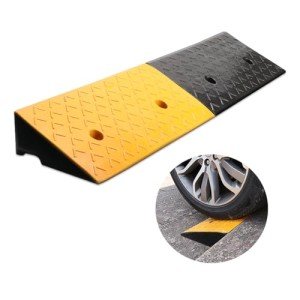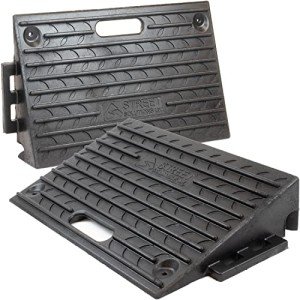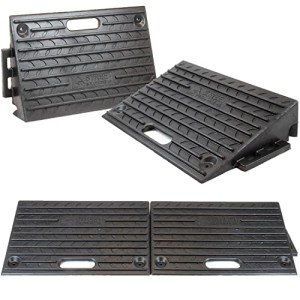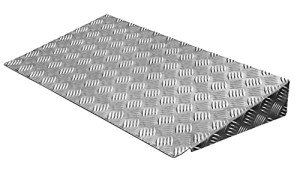Access and mobility are fundamental aspects of daily life for individuals using wheelchairs and scooters. The value of a threshold ramp, particularly one designed with innovative materials like rubber, cannot be overstated. This guide delves into the significance of 5cm rubber threshold ramps, exploring their benefits, installation, and maintenance, ultimately underscoring their contribution to enhancing accessibility.
Understanding Threshold Ramps
Threshold ramps serve a critical function: they bridge the gap between different surfaces, allowing for smoother transitions for wheelchair users. Ramps are crucial in locations where there are elevation discrepancies, such as doorways, curbs, or steps. Rubber threshold ramps, specifically those with a height of 5cm, are designed to cater to specific needs in a variety of settings.
Why Choose Rubber?
Rubber is a popular choice for ramp construction due to its durability, flexibility, and safety features. Here are some reasons why rubber ramps are particularly advantageous:
- Durability: Rubber is resistant to wear and tear, making it suitable for both indoor and outdoor use.
- Anti-Slip Characteristics: The texture of rubber helps prevent slips, which is essential for user safety.
- Lightweight: Rubber ramps are easier to transport and install compared to their metal or concrete counterparts.
- Weather Resistance: Rubber can withstand various weather conditions without deterioration, ensuring long-term usability.
- Eco-Friendly Options: Many rubber ramps are made from recycled materials, contributing to environmentally-friendly practices.
Benefits of Using a 5cm Rubber Threshold Ramp
When it comes to threshold ramps, a height of 5cm is often ideal for many environments. Here are some benefits associated with using a 5cm rubber threshold ramp:
- Ease of Use: A lower ramp height can significantly reduce the effort required to navigate surfaces, making it easier for users to go about their daily activities.
- Improved Accessibility: For homes and businesses, installing a 5cm threshold ramp can help meet accessibility standards and laws, ensuring compliance and inclusivity.
- Versatility: These ramps can be used in various locations, from residential properties to commercial buildings, as well as for outdoor events and venues.
- Customizable Solutions: Rubber threshold ramps can often be cut or modified to fit specific doorway widths or configurations.
Installation and Maintenance
Installation Process
Installing a 5cm rubber threshold ramp is generally a straightforward task. Here’s a brief outline of the process:
- Measure the Height: Confirm that the threshold height is 5cm.
- Select the Size: Choose a ramp size based on the width of the doorway or entry point. Options often vary.
- Prepare the Area: Ensure the area is clean and free from obstructions.
- Place the Ramp: Position the ramp against the threshold, ensuring it is stable and secure. A slight incline is recommended for smoother transitions.
- Add Non-Slip Tape: If extra traction is required, consider adhering non-slip tape to the ramp surface.
Maintenance Tips
Maintaining a rubber threshold ramp is relatively easy. Follow these tips to ensure longevity:
- Regular Cleaning: Sweep or rinse the ramp with water and mild detergent to prevent the accumulation of dirt and grime.
- Inspect for Damage: Periodically check for signs of wear or damage. Replace or repair any cracked or worn sections.
- Secure Installation: Ensure the ramp remains securely in place, especially in high-traffic areas.
FAQs
Q1: Where can I use a 5cm rubber threshold ramp?
A: These ramps can be installed in various locations, including homes, public buildings, schools, hospitals, and outdoor settings.
Q2: Are rubber ramps suitable for outdoor use?
A: Yes, rubber threshold ramps are designed to withstand various weather conditions, making them suitable for both indoor and outdoor environments.
Q3: How much weight can a rubber threshold ramp support?
A: Most rubber threshold ramps can support a weight capacity of approximately 300-600 pounds, but it is essential to check the manufacturer’s specifications.
Q4: Can I cut a rubber threshold ramp to fit my needs?
A: Many rubber ramps can be cut to size. However, it’s essential to follow the manufacturer's guidelines to avoid compromising the ramp's integrity.
Q5: Do I need a permit to install a ramp?
A: This can depend on local regulations. It is advisable to check with local authorities regarding any necessary permits before installation.
A 5cm rubber threshold ramp represents an indispensable tool for enhancing mobility and accessibility. Whether for personal use or business compliance, these ramps offer an efficient, durable, and easy-to-install solution for overcoming elevation barriers. With proper installation and maintenance, a rubber threshold ramp can serve as a reliable resource, ensuring that everyone, regardless of mobility challenges, can navigate their environment with dignity and ease.
In a world striving for inclusivity, the implementation of rubber threshold ramps plays a vital role in creating accessible spaces. Whether you are a business owner or a homeowner, investing in a rubber threshold ramp is a step towards a more inclusive environment.







